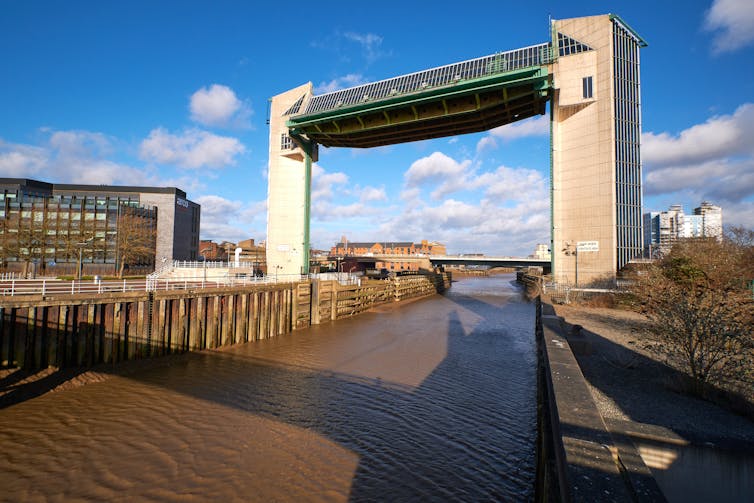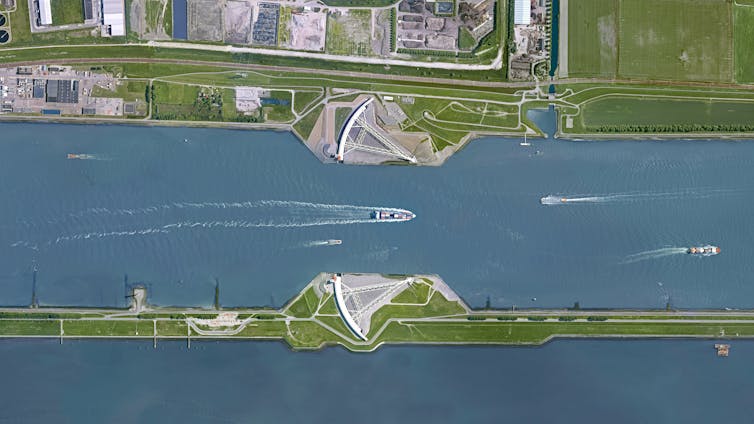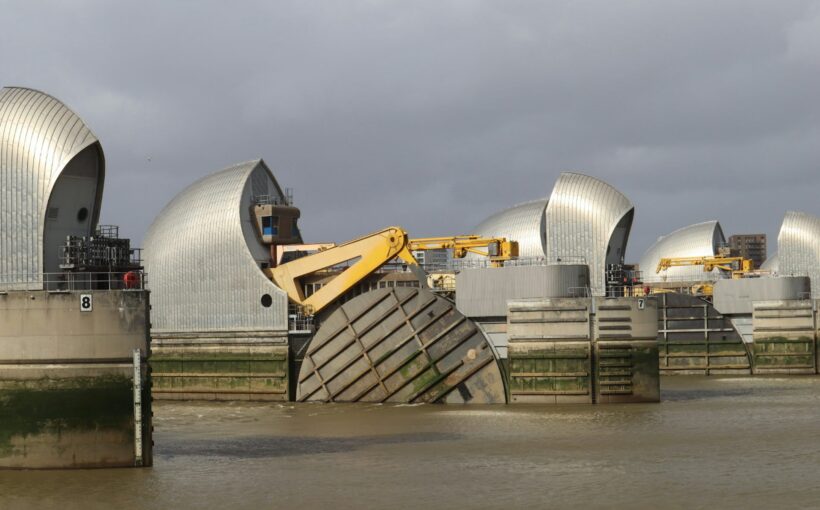
Flooding is the top environmental hazard identified in the UK’s National Risk Register, after a pandemic. Around one in six homes are currently at risk of flooding – a value likely to increase.
Many floods are caused by unusually high rainfall from successive storms which lead to saturated ground and then flooding. But flooding can also occur when high tides combine with strong winds that blow water towards the coast, resulting in extremely high water levels along the seaside and into estuaries.
This form of flooding happens less frequently, but is no less dangerous. In 1953 one of these “storm surges” killed more than 300 people along the east coast of Britain – it remains the country’s worst ever natural disaster. A similar surge struck during Storm Xaver in December 2013 but thanks to better flood defences, forecasts and warnings, there was no repeat of the 1953 damage.
One way the UK can respond to the growing risk these coastal floods, particularly in estuaries, is to build storm surge barriers. These are enormous metal and concrete structures with movable gates that can be closed temporarily to hold back storms and high tides, protecting people and property behind from coastal flooding.
There are four main storm surge barriers in the UK: Thames, Ipswich, Hull and Boston, alongside many smaller barriers. This network of defences reduces the risk for millions of people and helps protect billions of pounds worth of infrastructure. Completed in 1982, the Thames barrier in London is one of the world’s largest movable flood barriers shielding 125 square kilometres of central London and 1.42 million people.

Like cars, movable flood barriers need regular servicing to ensure all systems are working properly to allow them to close smoothly when needed. This means that there is a limit to the number of occasions flood barriers can close in a year while still allowing enough time for maintenance work.
That isn’t a problem when the barrier is rarely being used, the Thames Barrier only closed eight times in the entire 1980s. But in the record-breaking stormy winter of 2013/2014 it closed 50 times, equal to the maintenance limit. This is part of a trend driven by climate change: as sea-levels rise and storms get stronger, movable flood barriers are going to be called into action more often. This means more work will be needed to look after them with less time to carry out that work.
Learning with the Dutch
A country that is experiencing this challenge is the Netherlands. The Dutch are particularly vulnerable to flooding as the country is densely populated and 45% of its land lies below sea level.
The same 1953 storm that flooded the UK was even more devastating in the Netherlands, taking the lives of 1,836 people and causing €5.4 billion (£4.62 billion) worth of damage (in today’s money). This led the government to transform the country’s flood protection including the construction of six movable flood barriers with the world’s oldest – Hollandsche IJssel, completed in 1958 – and largest automatic – Maeslant barrier, completed in 1997.

The Dutch have a wealth of knowledge and experience in flood protection. This expertise is shared internationally through collaboration facilitated by I-STORM, an international network connecting and sharing knowledge between people working with movable flood barriers around the world.
But even in the Netherlands things need to be changed. We recently published research on the Maeslant barrier which revealed that although it has only closed once in its 26-year lifetime, on December 21 2023, the amount of work needed to keep the barrier functioning is increasing and no longer fits into the summer maintenance period. This makes it difficult to achieve the safety standards required by law. Without changes to the way the barrier is looked after, it will not reach its planned lifetime and will not keep up with rising sea levels.
Heading into an uncertain future
Back in the UK, new movable flood defences are being built across Britain to protect more people and properties. The Boston barrier in Lincolnshire became operational in 2021 to increase flood protection for 14,300 properties. And work has begun on a new barrier in Bridgwater, Somerset designed to protect 13,000 homes and businesses.
Plans are also underway to replace existing barriers. For instance, the government’s Thames Estuary 2100 plan estimates that the Thames barrier will reach the end of its life in 2070. Further sea level rise will mean the barrier closes with increasing frequency making it harder to maintain, holding up ship traffic, and harming the health of the river. Although this is more than 40 years away, work has already begun planning a new movable flood defence to continue keeping high tides out of London.
This forward planning has put the UK on the front foot and keeps it resilient to the risks posed by sea-level rise, changing climate and coastal flooding. But, with more devastating weather records being broken each passing year, and the ever present threat of climate change bearing down on us, it is likely that flood barriers and coastal defences will become more important as we head into an uncertain future.
![]()
Sunke Trace-Kleeberg’s PhD is funded by the Natural Environment Research Council (NERC), Rijkswaterstaat, Southampton Marine and Maritime Institute (SMMI) and the Environment Agency (EA).
Ivan Haigh receives funding from the Natural Environment Research Council (NERC), Rijkswaterstaat and the Environment Agency (EA).



